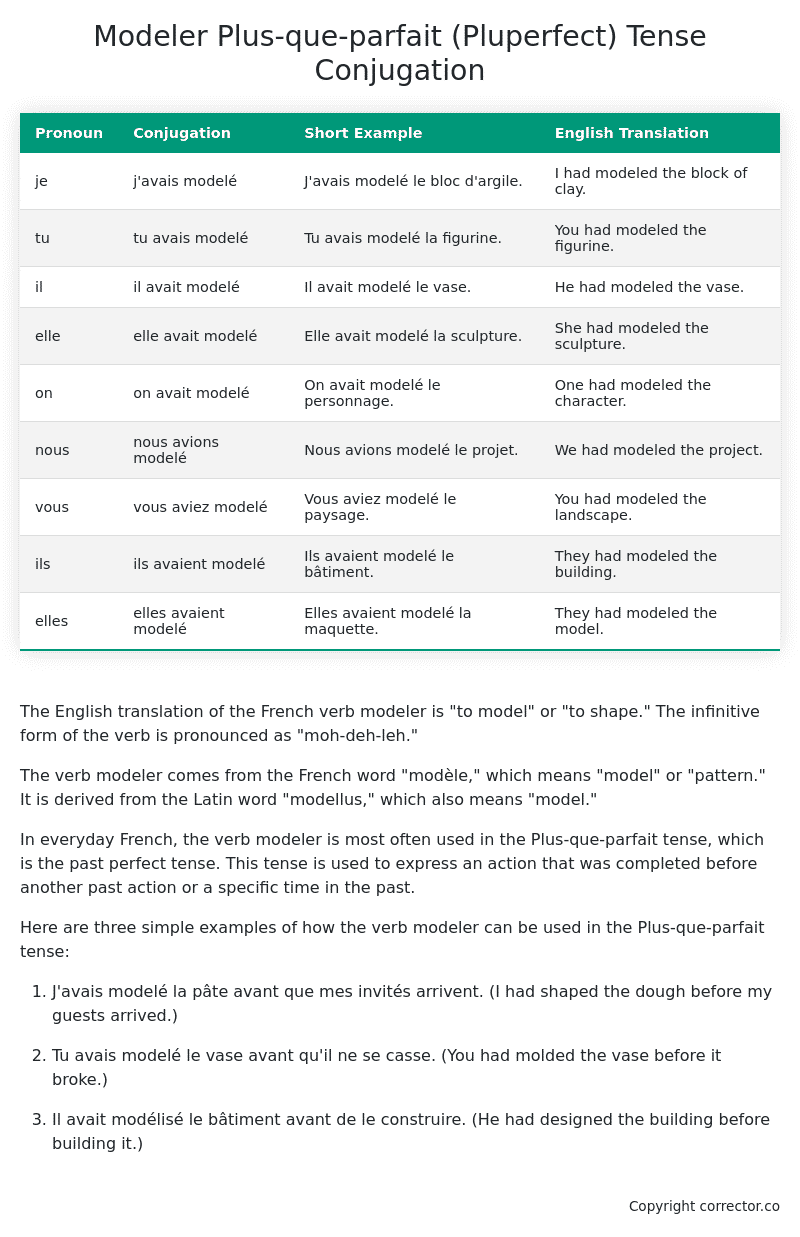Plus-que-parfait (Pluperfect) Tense Conjugation of the French Verb modeler
Introduction to the verb modeler
The English translation of the French verb modeler is “to model” or “to shape.” The infinitive form of the verb is pronounced as “moh-deh-leh.”
The verb modeler comes from the French word “modèle,” which means “model” or “pattern.” It is derived from the Latin word “modellus,” which also means “model.”
In everyday French, the verb modeler is most often used in the Plus-que-parfait tense, which is the past perfect tense. This tense is used to express an action that was completed before another past action or a specific time in the past.
Here are three simple examples of how the verb modeler can be used in the Plus-que-parfait tense:
-
J’avais modelé la pâte avant que mes invités arrivent. (I had shaped the dough before my guests arrived.)
-
Tu avais modelé le vase avant qu’il ne se casse. (You had molded the vase before it broke.)
-
Il avait modélisé le bâtiment avant de le construire. (He had designed the building before building it.)
Table of the Plus-que-parfait (Pluperfect) Tense Conjugation of modeler
| Pronoun | Conjugation | Short Example | English Translation |
|---|---|---|---|
| je | j’avais modelé | J’avais modelé le bloc d’argile. | I had modeled the block of clay. |
| tu | tu avais modelé | Tu avais modelé la figurine. | You had modeled the figurine. |
| il | il avait modelé | Il avait modelé le vase. | He had modeled the vase. |
| elle | elle avait modelé | Elle avait modelé la sculpture. | She had modeled the sculpture. |
| on | on avait modelé | On avait modelé le personnage. | One had modeled the character. |
| nous | nous avions modelé | Nous avions modelé le projet. | We had modeled the project. |
| vous | vous aviez modelé | Vous aviez modelé le paysage. | You had modeled the landscape. |
| ils | ils avaient modelé | Ils avaient modelé le bâtiment. | They had modeled the building. |
| elles | elles avaient modelé | Elles avaient modelé la maquette. | They had modeled the model. |
Other Conjugations for Modeler.
Le Present (Present Tense) Conjugation of the French Verb modeler
Imparfait (Imperfect) Tense Conjugation of the French Verb modeler
Passé Simple (Simple Past) Tense Conjugation of the French Verb modeler
Passé Composé (Present Perfect) Tense Conjugation of the French Verb modeler
Futur Simple (Simple Future) Tense Conjugation of the French Verb modeler
Futur Proche (Near Future) Tense Conjugation of the French Verb modeler
Plus-que-parfait (Pluperfect) Tense Conjugation of the French Verb modeler (this article)
Passé Antérieur (Past Anterior) Tense Conjugation of the French Verb modeler
Futur Antérieur (Future Anterior) Tense Conjugation of the French Verb modeler
Subjonctif Présent (Subjunctive Present) Tense Conjugation of the French Verb modeler
Subjonctif Passé (Subjunctive Past) Tense Conjugation of the French Verb modeler
Subjonctif Imparfait (Subjunctive Imperfect) Tense Conjugation of the French Verb modeler
Subjonctif Plus-que-parfait (Subjunctive Pluperfect) Tense Conjugation of the French Verb modeler
Conditionnel Présent (Conditional Present) Tense Conjugation of the French Verb modeler
Conditionnel Passé (Conditional Past) Tense Conjugation of the French Verb modeler
L’impératif Présent (Imperative Present) Tense Conjugation of the French Verb modeler
L’infinitif Présent (Infinitive Present) Tense Conjugation of the French Verb modeler
Struggling with French verbs or the language in general? Why not use our free French Grammar Checker – no registration required!
Get a FREE Download Study Sheet of this Conjugation 🔥
Simply right click the image below, click “save image” and get your free reference for the modeler Plus-que-parfait tense conjugation!

Modeler – About the French Plus-que-parfait (Pluperfect) Tense
Tense Formation
Common everyday usage patterns
Sequencing of past events
Background information
Hypothetical or reported speech
Interactions with other tenses
Summary
I hope you enjoyed this article on the verb modeler. Still in a learning mood? Check out another TOTALLY random French verb conjugation!


